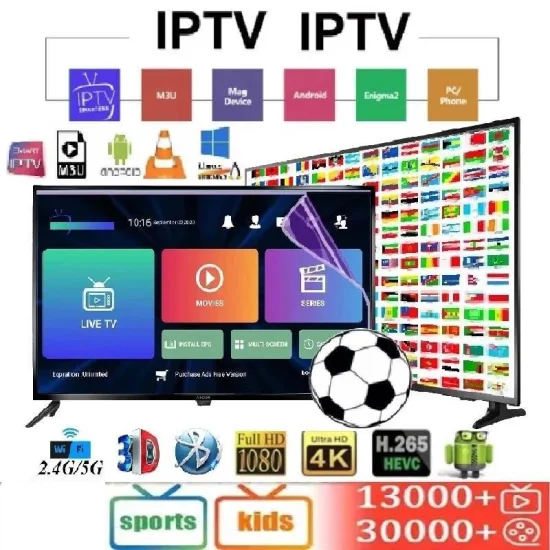Gain Access To Premium Content: IPTV Subscription Program Tailored to You
Gain Access To Premium Content: IPTV Subscription Program Tailored to You
Blog Article
How IPTV Works: A Step-by-Step Guide to Net Method Tv Innovation
Net Method Television (IPTV) has actually transformed the means we eat television material, using a new world of opportunities with the power of the net. Recognizing the intricacies of just how IPTV functions can drop light on the technology that drives this cutting-edge type of media delivery. From the basic concepts of IPTV to the intricate procedure of web content distribution, each action plays a critical function in making certain a smooth watching experience. In this overview, we will uncover the hidden systems that make IPTV a fascinating blend of technology and home entertainment.
IPTV Basics
In understanding IPTV fundamentals, it is critical to grasp the basic operations of this technology in delivering tv web content over the net. IPTV, which stands for Internet Method Television, makes use of Internet Protocol (IP) networks to transmit tv content to individuals' gadgets. Unlike standard techniques of broadcasting tv web content with cable television or satellite signals, IPTV streams media with high-speed internet connections.

Furthermore, IPTV enables interactive capacities, such as video on demand (VOD) and electronic program overviews (EPG), enhancing the user experience by providing more control and versatility in accessing web content. In general, recognizing the basics of IPTV establishes the foundation for discovering its more innovative capabilities and the benefits it supplies to modern tv usage.
Material Delivery Process
Efficient web content delivery in IPTV systems involves a well-structured process that guarantees seamless transmission of tv material over IP networks. The content delivery process in IPTV starts with the production of the video clip content, which is then inscribed into electronic layout appropriate for IP transmission. This encoded material is after that securely saved on servers recognized as media servers. When a visitor demands particular content, the IPTV system recovers the requested information from the media web servers and provides it to the customer's gadget over the web.

Middleware Capability
With the integration of middleware, IPTV systems gain enhanced functionality that simplifies individual communication and material administration. Middleware functions as a vital element that links the gap visite site between the user interface and the back-end infrastructure, facilitating smooth communication and communication within the IPTV system. One of the vital features of middleware in IPTV is to enable tailored customer experiences by offering features such as interactive program overviews, video-on-demand solutions, interactive advertising, and user choices monitoring. By streamlining these performances via middleware, company read this post here can use a more vibrant and customized IPTV experience to their customers.

Device Compatibility
Provided the essential role of middleware in enabling smooth communication and material administration in IPTV systems, a critical facet to think about is the compatibility of tools utilized for accessing the IPTV solutions. Device compatibility is vital for ensuring a smooth individual experience and optimum efficiency when accessing IPTV web content.
In the context of IPTV, device compatibility describes the capacity of a gadget to properly connect with the IPTV service, display material correctly, and support the required methods and codecs for streaming video web content online. Different devices, such as smart Televisions, set-top boxes, smart devices, tablets, and computer systems, may have varying degrees of compatibility with IPTV services.
To make sure a seamless watching experience, it is essential for individuals to select gadgets that are suitable with the specific IPTV solution they are using. Furthermore, IPTV solution suppliers must use assistance for a large range of tools to provide to the varied requirements of their customer base. By focusing on gadget compatibility, both users and provider can improve the overall IPTV experience.
Top Quality of Solution (QoS)
Thinking about the important duty of maintaining a high criterion of efficiency and reliability in IPTV systems, guaranteeing regular Top quality of Service (QoS) continues to be a basic element of the user experience. QoS in IPTV refers to the capability of the system to provide web content with marginal disturbances, high resolution, and quickly loading times.
Provider use QoS devices such as web traffic prioritization, buffering, and mistake adjustment to keep a secure IPTV service. By prioritizing IPTV traffic over much less time-sensitive information, service providers can make sure smooth playback also throughout height usage hours. Buffering aids make up for network changes, while error improvement techniques enhance data stability.
Continuous tracking and optimization of QoS parameters are important to adapt to changing network conditions and user demands. Eventually, a robust QoS structure is vital for providing a seamless and enjoyable IPTV experience to users.
Verdict
In conclusion, IPTV operates with the transmission of television material over net procedure networks. Top quality of Solution plays a crucial role in keeping the performance and dependability of see this IPTV solutions - IPTV subscription.
Report this page